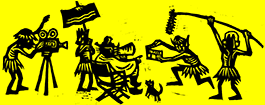|
| |
 |
|
|
| |
 |
鳳甲美術館 Hong-Gah Museum
|
台北市11268北投區大業路166號11樓(近捷運淡水線奇岩站)
開放時間 Open Hours 10:30-17:30(週一休館 Closed on Monday)
11F., No. 166, Daye Road, Beitou District, Taipei City 11268, Taiwan
TEL 886-2-28942272︱www.hong-gah.org.tw
|
|
| |
| |
|
 |
|
| |
| 林欣怡 |
|
| 台灣 |
|
三島.小說:張正光
2014,單頻錄像,31分
|
|
| LIN Hsin-I |
|
| Taiwan |
|
Triple Islands-Novel: CHANG Cheng-Kuang
2014, single-channel video, 31'00" |
|
|
|
|
| 林欣怡近年以拍攝藝術家的藝術家狀態,進行行動影像的創作計畫,《三島.小說》是她的「哪吒體」式影像敘事的新作,追拍對象為藝術家「高俊宏」。台灣、沖繩、濟州島在二次大戰後看似進入各自的命運,但此三個島嶼皆不約而同地承載著異種同政的歷史質地。台灣的二二八、沖繩島戰役的集體自決、濟州島的四.三事件等,皆是發生於1940年代起直至近年的重要政治事件,這些事件影響了這三個島嶼上的個人生命現狀,亦折射出島嶼人民集體性的個人內戰。如果我們再將地標延展至香港,那麼2006 年的天星碼頭事件、2011 年佔領中環運動等,無不是東亞個人集結為共同體的重要政治實踐。藝術家高俊宏透過《小說》之出版,將自身多年來於此東亞諸島之觀察研究與藝術行動實踐,轉譯為虛實交錯的敘事文學表述此段未明的歷史路徑。如果藝術家以個人生命作為創作物質,那麼紀錄此物質的直捷方法或許是紀錄片式的影像文本承諾。《三島.小說》紀錄影像嘗試著從文學書寫,轉向身體場景之真實定影。透過由文學、藝術家個人研究實踐作為劇本,平行發展為肉身的雙重轉環運動,陳述東亞三島的未名歷史與徵候性解讀。 |
LIN Hsin-I in recent years engages herself in a creative project of action images based on artists that film artists. "Triple Island-Novel" is her new work of "Nezha-style" video narrative. Taiwan, Okinawa, and Jeju Island seemed to undertake their separate destinies after World War II, and yet the three islands carry an isomorphic historical texture. The 228 incident of Taiwan, the mass suicide of the Battle of Okinawa, and the 4.3 Incident on Jeju Island (also known as "Jeju Uprising") are the critical political events occurred from 1940 to recent years. These events not only affect the lives of individuals on the 3 islands to date, but reflect the collective civil war within the individuals on the islands. Hence, if we extend it to Hong Kong as one of the landmarks, the Star Ferry Pier Preservation Protest in 2006, the Occupy Central in 2011, etc. are as well the important political practices of individuals of East Asia united as one. The artist KAO Jun-Honn, via the publishing of "Novel", translated his observations, researches, and artistic practices on these East Asian islands into a semi-fictional narrative literature to depict such unknown track of history. If the artists use their personal lives as creative materials, the direct approach to document such material would be the commitment of documentary image texts. Triple Islands-Novel's documentary images try to shift from literary writings to the actual fixing of body-scene. Adopting literatures as well as the personal research and practices of artists as scripts, parallel with reversible movements of the flesh, the work recounts the unknown history and the symptomatic interpretations of the 3 islands of East Asia. |
|
|
|